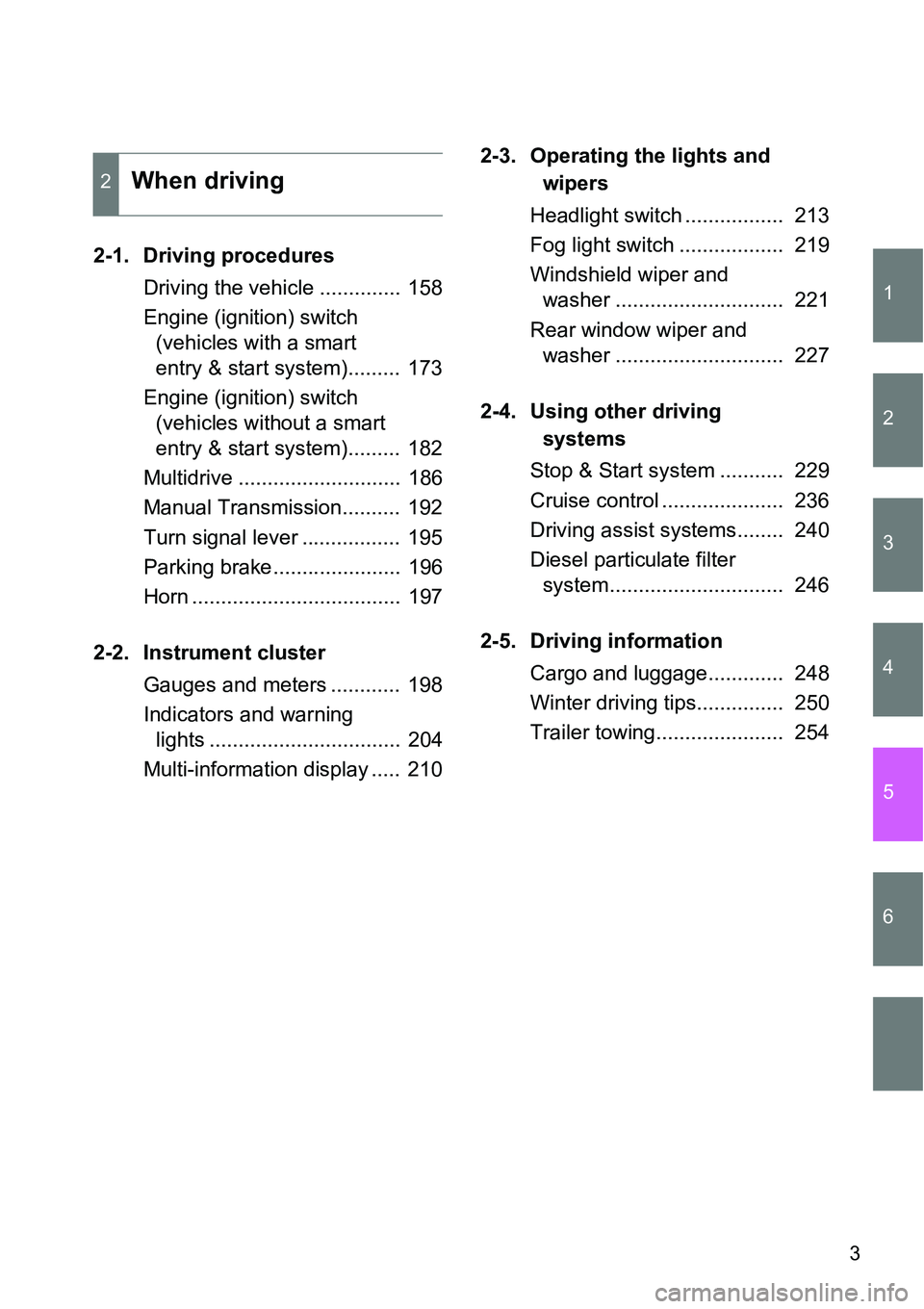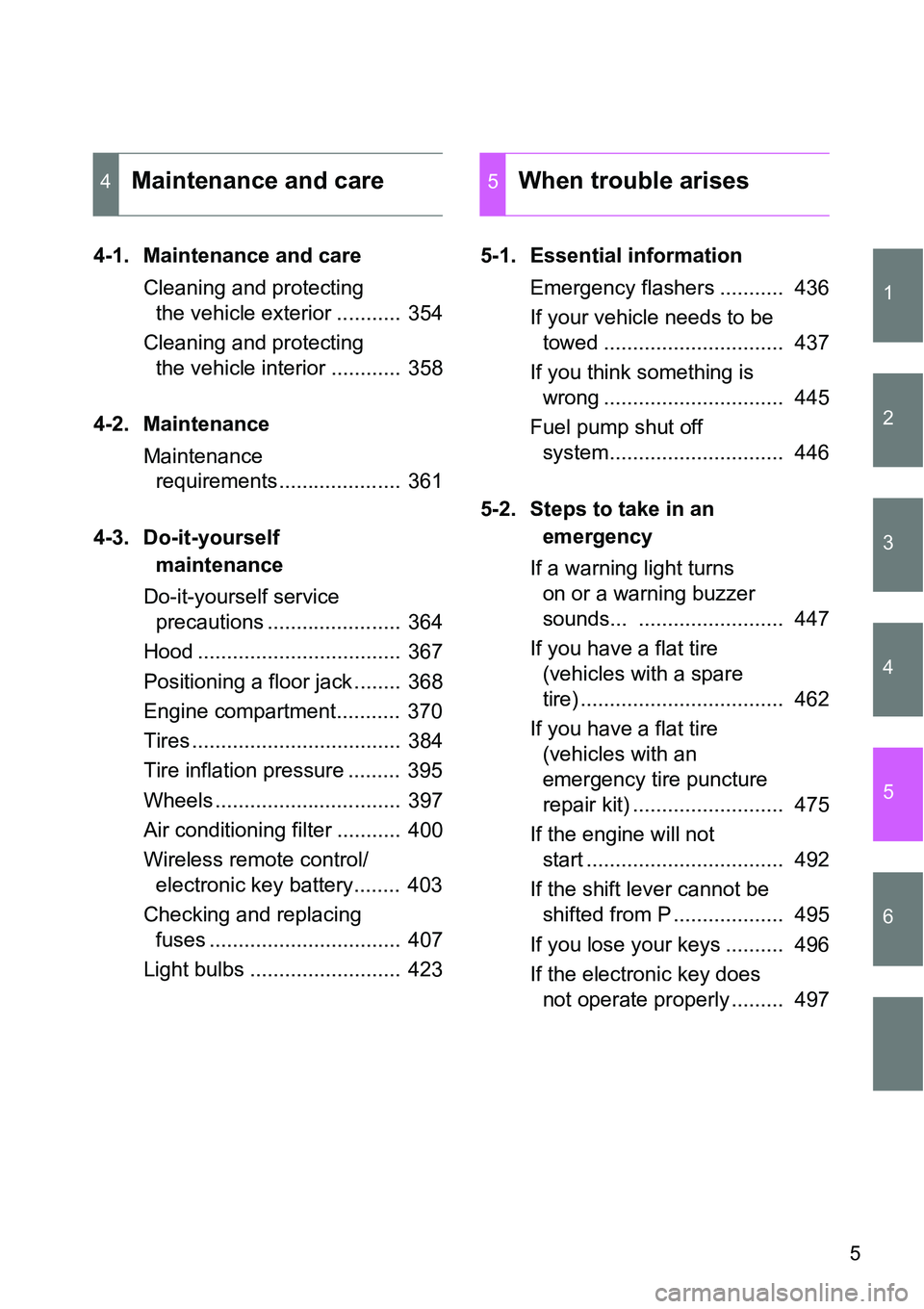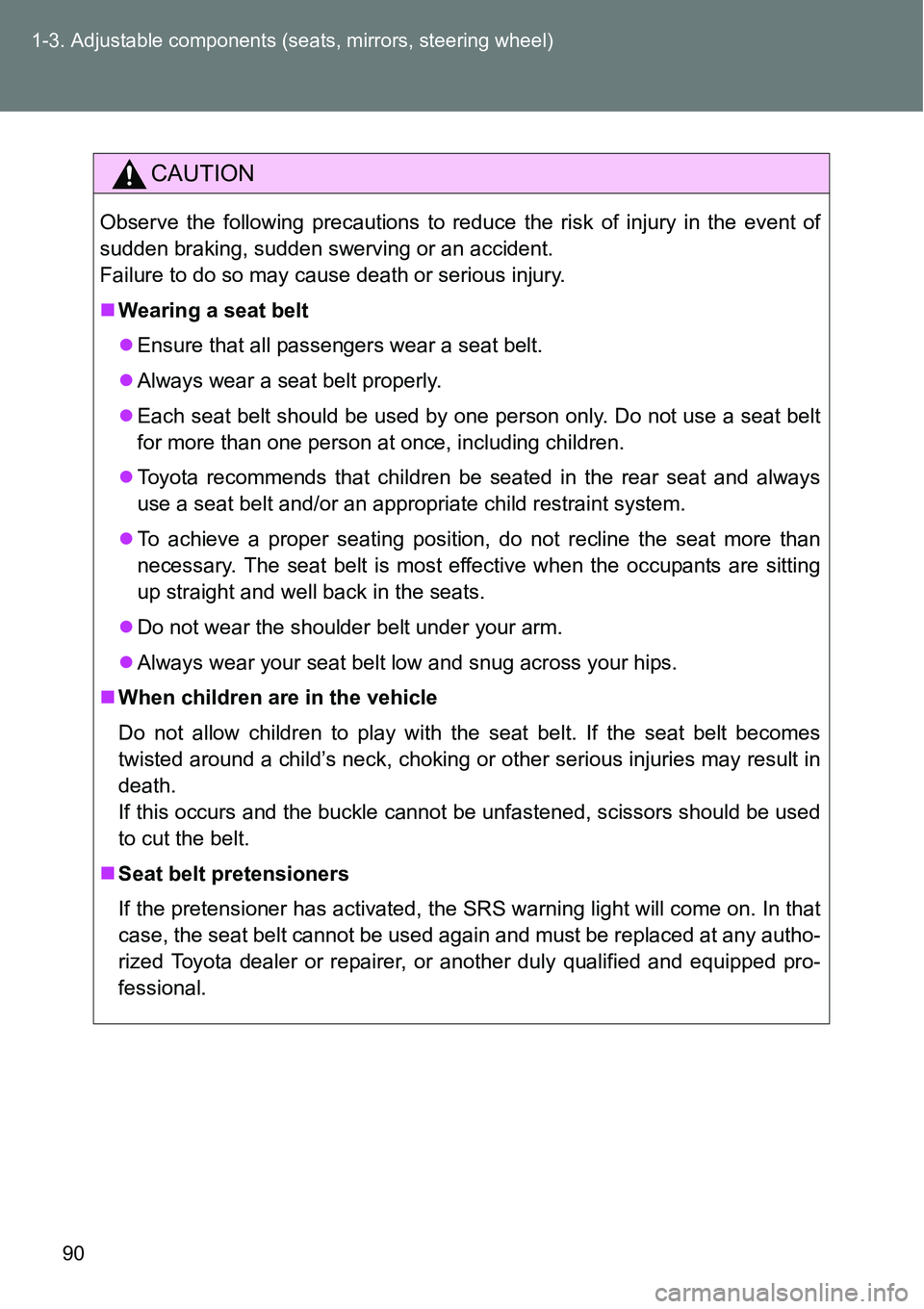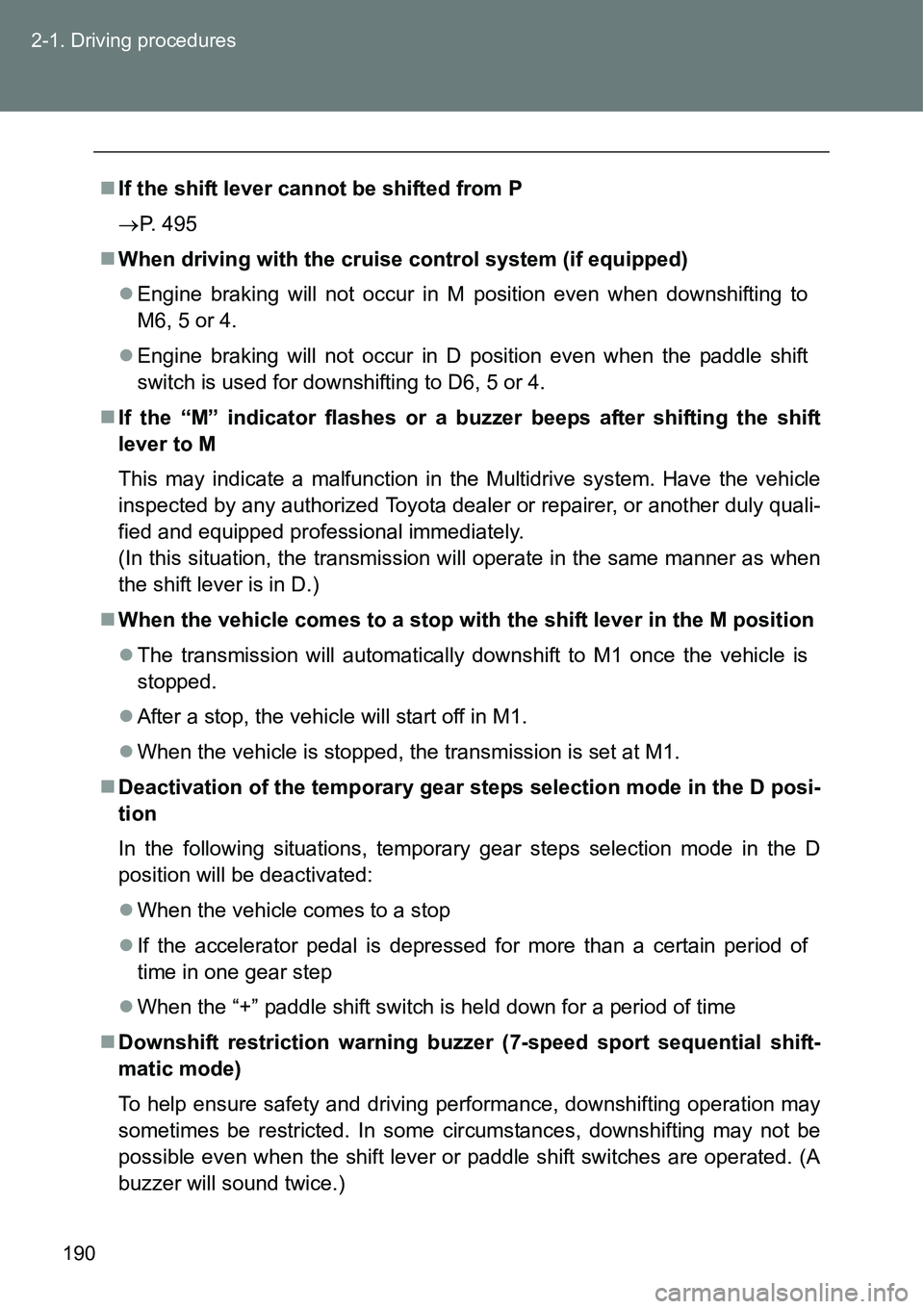Page 3 of 564

1
2
3
4
5
6
3
2-1. Driving procedures
Driving the vehicle .............. 158
Engine (ignition) switch
(vehicles with a smart
entry & start system)......... 173
Engine (ignition) switch
(vehicles without a smart
entry & start system)......... 182
Multidrive ............................ 186
Manual Transmission.......... 192
Turn signal lever ................. 195
Parking brake...................... 196
Horn .................................... 197
2-2. Instrument cluster
Gauges and meters ............ 198
Indicators and warning
lights ................................. 204
Multi-information display ..... 2102-3. Operating the lights and
wipers
Headlight switch ................. 213
Fog light switch .................. 219
Windshield wiper and
washer ............................. 221
Rear window wiper and
washer ............................. 227
2-4. Using other driving
systems
Stop & Start system ........... 229
Cruise control ..................... 236
Driving assist systems........ 240
Diesel particulate filter
system.............................. 246
2-5. Driving information
Cargo and luggage............. 248
Winter driving tips............... 250
Trailer towing...................... 254
2When driving
Page 5 of 564

1
2
3
4
5
6
5
4-1. Maintenance and care
Cleaning and protecting
the vehicle exterior ........... 354
Cleaning and protecting
the vehicle interior ............ 358
4-2. Maintenance
Maintenance
requirements..................... 361
4-3. Do-it-yourself
maintenance
Do-it-yourself service
precautions ....................... 364
Hood ................................... 367
Positioning a floor jack ........ 368
Engine compartment........... 370
Tires .................................... 384
Tire inflation pressure ......... 395
Wheels ................................ 397
Air conditioning filter ........... 400
Wireless remote control/
electronic key battery........ 403
Checking and replacing
fuses ................................. 407
Light bulbs .......................... 4235-1. Essential information
Emergency flashers ........... 436
If your vehicle needs to be
towed ............................... 437
If you think something is
wrong ............................... 445
Fuel pump shut off
system.............................. 446
5-2. Steps to take in an
emergency
If a warning light turns
on or a warning buzzer
sounds... ......................... 447
If you have a flat tire
(vehicles with a spare
tire) ................................... 462
If you have a flat tire
(vehicles with an
emergency tire puncture
repair kit) .......................... 475
If the engine will not
start .................................. 492
If the shift lever cannot be
shifted from P ................... 495
If you lose your keys .......... 496
If the electronic key does
not operate properly ......... 497
4Maintenance and care5When trouble arises
Page 27 of 564
27
Symbols used throughout this manual
Cautions & Notices
Symbols used in illustrations
CAUTION
This is a warning against something which, if ignored, may cause death or
serious injury to people. You are informed about what you must or must not do
in order to reduce the risk of death or serious injury to yourself and others.
NOTICE
This is a warning against something which, if ignored, may cause damage to
the vehicle or its equipment. You are informed about what you must or must
not do in order to avoid or reduce the risk of damage to your Toyota and its
equipment.
Safety symbol
The symbol of a circle with a slash through it means “Do not”, “Do
not do this”, or “Do not let this happen”.
Arrows indicating operations
Indicates the action (pushing, turning,
etc.) used to operate switches and other
devices.
Indicates the outcome of an operation
(e.g. a lid opens).
Page 38 of 564
38 1-2. Opening, closing and locking the doors
Operation signals
The emergency flashers flash to indicate that the doors have been locked/
unlocked. (Locked: once; Unlocked: twice)
When the door cannot be locked by the lock sensor
Alarms and warning indicators
A combination of exterior and interior alarms as well as warning lights are
used to prevent theft of the vehicle and unforeseeable accidents resulting
from erroneous operation. Take appropriate measures for the warning light
that comes on. (P. 455)
The following table describes circumstances and correction procedures
when only alarms are sounded.
Use your palm to touch the lock sensor.
Page 90 of 564

90 1-3. Adjustable components (seats, mirrors, steering wheel)
CAUTION
Observe the following precautions to reduce the risk of injury in the event of
sudden braking, sudden swerving or an accident.
Failure to do so may cause death or serious injury.
Wearing a seat belt
Ensure that all passengers wear a seat belt.
Always wear a seat belt properly.
Each seat belt should be used by one person only. Do not use a seat belt
for more than one person at once, including children.
Toyota recommends that children be seated in the rear seat and always
use a seat belt and/or an appropriate child restraint system.
To achieve a proper seating position, do not recline the seat more than
necessary. The seat belt is most effective when the occupants are sitting
up straight and well back in the seats.
Do not wear the shoulder belt under your arm.
Always wear your seat belt low and snug across your hips.
When children are in the vehicle
Do not allow children to play with the seat belt. If the seat belt becomes
twisted around a child’s neck, choking or other serious injuries may result in
death.
If this occurs and the buckle cannot be unfastened, scissors should be used
to cut the belt.
Seat belt pretensioners
If the pretensioner has activated, the SRS warning light will come on. In that
case, the seat belt cannot be used again and must be replaced at any autho-
rized Toyota dealer or repairer, or another duly qualified and equipped pro-
fessional.
Page 123 of 564
123 1-7. Safety information
1
Before driving
SRS airbag system components
The main SRS airbag system components are shown above. The
SRS airbag system is controlled by the airbag sensor assembly. As
the airbags deploy, a chemical reaction in the inflators quickly fills the
airbags with non-toxic gas to help restrain the motion of the occu-
pants.Curtain shield airbags
Side airbags
“PASSENGER AIR BAG”
indicator lights
Side impact sensors (rear)
SRS warning light
Side impact sensors (front)Seat belt pretensioners and
force limiters
Driver airbag
Knee airbag
Airbag sensor assembly
Front impact sensor
Airbag manual on-off switch
Front passenger airbag
Page 157 of 564

2When driving
157
2-1. Driving procedures
Driving the vehicle ............ 158
Engine (ignition) switch
(vehicles with a smart
entry & start system)....... 173
Engine (ignition) switch
(vehicles without a smart
entry & start system)....... 182
Multidrive .......................... 186
Manual Transmission ....... 192
Turn signal lever ............... 195
Parking brake ................... 196
Horn .................................. 197
2-2. Instrument cluster
Gauges and meters .......... 198
Indicators and warning
lights ............................... 204
Multi-information
display ............................ 2102-3. Operating the lights and
wipers
Headlight switch................ 213
Fog light switch ................. 219
Windshield wiper and
washer ............................ 221
Rear window wiper and
washer ............................ 227
2-4. Using other driving
systems
Stop & Start system .......... 229
Cruise control.................... 236
Driving assist systems ...... 240
Diesel particulate filter
system ............................ 246
2-5. Driving information
Cargo and luggage ........... 248
Winter driving tips ............. 250
Trailer towing .................... 254
Page 190 of 564

190 2-1. Driving procedures
If the shift lever cannot be shifted from P
P. 495
When driving with the cruise control system (if equipped)
Engine braking will not occur in M position even when downshifting to
M6, 5 or 4.
Engine braking will not occur in D position even when the paddle shift
switch is used for downshifting to D6, 5 or 4.
If the “M” indicator flashes or a buzzer beeps after shifting the shift
lever to M
This may indicate a malfunction in the Multidrive system. Have the vehicle
inspected by any authorized Toyota dealer or repairer, or another duly quali-
fied and equipped professional immediately.
(In this situation, the transmission will operate in the same manner as when
the shift lever is in D.)
When the vehicle comes to a stop with the shift lever in the M position
The transmission will automatically downshift to M1 once the vehicle is
stopped.
After a stop, the vehicle will start off in M1.
When the vehicle is stopped, the transmission is set at M1.
Deactivation of the temporary gear steps selection mode in the D posi-
tion
In the following situations, temporary gear steps selection mode in the D
position will be deactivated:
When the vehicle comes to a stop
If the accelerator pedal is depressed for more than a certain period of
time in one gear step
When the “+” paddle shift switch is held down for a period of time
Downshift restriction warning buzzer (7-speed sport sequential shift-
matic mode)
To help ensure safety and driving performance, downshifting operation may
sometimes be restricted. In some circumstances, downshifting may not be
possible even when the shift lever or paddle shift switches are operated. (A
buzzer will sound twice.)